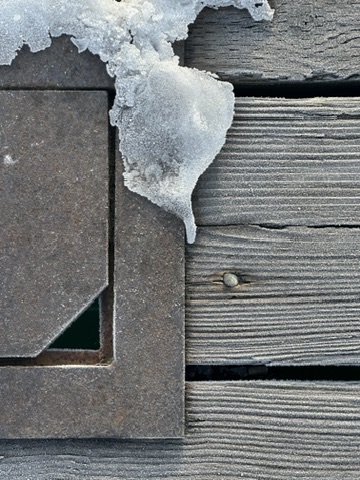
Introduction:
The artwork under review is a photograph capturing a detail-oriented, abstract composition featuring natural textures and contrasting materials, specifically ice and wood, alongside a rusty metallic surface.
1. Visual Analysis:
Composition and Framing:
The composition is arranged asymmetrically, clearly dividing the image into distinct quadrants. The metal component occupies the lower-left section, while the weathered wooden planks fill the remaining frame. Ice partially overlays the metal surface and extends into the upper frame, creating a fluid visual flow and a dynamic balance.
Form and Anatomy:
The subjects captured include a rusted metallic plate with a geometric cutout, textured wooden planks marked by deep grooves and visible grain, and melting ice with a dripping, organic shape. The ice has a distinctive form, appearing frozen in mid-motion, as it slowly melts downward.
Use of Light and Shadow:
Natural, diffused lighting illuminates the subjects evenly, highlighting textures without creating harsh contrasts. Shadows are minimal but accentuate the depth of wood grain and rust texture, subtly enhancing visual clarity and depth.
Textures and Surfaces:
The photograph emphasizes contrasting textures: rough, granular ice; weathered, linear wood; and coarse, corroded metal. The interplay between these textures is a prominent visual theme, creating tactile interest and depth.
Color Palette and Tonality:
The palette is muted and cool-toned, dominated by neutral grays, browns, and subtle blue hues within the ice. The tonal contrasts are mild but effective, emphasizing the differences in surface texture and material properties.
Background and Context:
The close-up framing provides little contextual reference, leaving ambiguity about the broader setting. This abstract approach invites viewers to consider the beauty and significance of mundane, often overlooked details in the natural and human-made environment.
2. Philosophical Reflection:
Identify Core Themes:
Key themes include impermanence, transition, and the relationship between human-made and natural worlds. The melting ice symbolizes transient states, hinting at themes of change and the passage of time.
Symbolism and Metaphors:
The melting ice can metaphorically represent human vulnerability, transience, and the inevitability of change. The juxtaposition of rusting metal and aged wood further symbolizes decay and renewal, suggesting cycles of deterioration and rejuvenation.
Questions Raised:
The artwork prompts philosophical inquiry into humanity’s impact on nature, the resilience of natural processes versus manufactured structures, and questions regarding the inevitability of decay and transformation over time.
Connection to Human Condition:
The photo’s exploration of decay and renewal mirrors universal aspects of the human experience: our attempts to construct permanence against the inevitable forces of time and nature. It subtly invites reflection on acceptance and adaptation in the face of unavoidable change.
3. Practical Photography Insights:
Lighting and Texture Techniques:
The photographer expertly utilizes natural, diffused lighting to emphasize subtle textures and intricate details without overpowering the composition. This approach effectively highlights the interplay of textures and creates a serene yet intriguing visual experience. Slightly stronger directional lighting could enhance depth further, but the current choice retains balance and harmony.
Color and Tonal Choices:
The subtle and muted tonal range effectively emphasizes the textures rather than overpowering them. Choosing a monochromatic or desaturated palette is particularly successful in elevating the abstract, reflective mood. More vibrant color might detract from this contemplative effect.
Focus and Depth:
The focus is sharp throughout, enhancing every intricate detail in textures and forms. Given the abstract nature, this uniform sharpness successfully guides viewers’ attention across the entire image rather than restricting it to a single focal point.
Compositional Decisions:
The decision to tightly crop the composition and omit broader context effectively emphasizes abstract qualities and intimate details. The geometric metal structure creates a visual anchor, balancing the organic forms of ice and wood textures, achieving a compelling composition.
4. Reflections:
Emotional and Intellectual Response:
The photograph evokes quiet contemplation and gentle introspection, urging viewers to notice and appreciate subtle beauty in everyday details. It effectively fosters awareness of temporality, transience, and natural cycles.
Artistic Strengths:
The artwork’s strength lies in its textural contrast, thoughtful composition, and understated color palette. The combination of organic and geometric elements creates intriguing visual tension, effectively communicating its thematic depth.
Overall Significance:
This photograph stands out due to its simplicity and insightful exploration of materiality, temporality, and natural beauty. The artist successfully merges technical skill with philosophical reflection, resulting in a visually appealing and intellectually stimulating piece.
Lingering Questions or Impressions:
It leaves the viewer contemplating what lies beyond the frame, symbolically reinforcing its themes of uncertainty and the unknown, effectively resonating long after the initial viewing.
